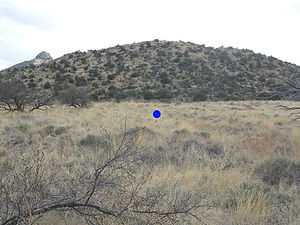Bascom Affair

| ||||||
The Bascom Affair is considered to be the key event triggering the 1860s Apache War. The Apache Wars were fought during the nineteenth century between the U.S. military and many tribes in what is now the southwestern United States. The incident took place in 1861 in the area known as Arizona and New Mexico.
Trigger
The Bascom Affair began on January 27, 1861, when Tonto Apache Indian parties raided the ranch of John Ward at Sonoita Creek, stealing several livestock and kidnapping Ward's 12-year-old stepson Felix Ward.[1] Ward complained about the raid to the nearby military authority, Lieutenant Colonel Morrison, the commandant of Fort Buchanan, Arizona, who directed Lieutenant George Nicholas Bascom and a large group of infantry to attempt to recover the boy. Bascom and his men were unable to locate the boy or the tribe. Bascom determined that the raid was done by Chiricahua Apache Indians. Morrison ordered Bascom to use whatever means necessary to punish the kidnappers and recapture the boy.[2] Bascom, Ward, and 54 soldiers journeyed east to the Apache Pass, arriving on February 3, 1861, and met Sergeant Daniel Robinson, who would accompany them for the rest of the expedition. Bascom convinced an Indian leader named Cochise to meet with him. Suspicious of Bascom's plans, Cochise brought with him his brother Coyuntwa, two nephews, his wife, and his two children.[3] At the meeting, Cochise claimed he knew nothing of the affair. Doubting the Indian's honesty, Bascom attempted to imprison him and his family in a tent to be held hostage, but Cochise was able to escape with only a leg wound.[4]
On February 5, 1861, Cochise delivered a message to Bascom pleading for the release of his family, but Bascom refused and told Cochise that they "would be set free just so soon as the boy was released".[5] The following day, Cochise and a large party of Apaches attacked a group of Americans and captured three hostages, offering them in exchange for his family, but Bascom maintained that he would accept nothing other than the return of the boy and cattle. On February 7, 1861, Cochise and his men attacked Bascom's soldiers while they were fetching water.[6]
According to recent sources, Cochise was known for his truthfulness and integrity and Bascom's accusations were unsubstantiated.[7]
Outcome
Cochise fled to Sonora. On the way, he killed the American prisoners and left their remains to be discovered by Bascom. Several days later on February 19, 1861, Bascom hanged Cochise's brother and nephews before he and his soldiers began their journey home.[8]
The moment when Cochise discovered his brother and nephews dead has been called the moment when the Indians (the Chiricahua in particular) transferred their hatred of the Mexicans to the Americans.[9] Cochise's revenge in the form of numerous raids and murders was the beginning of the 25-year-long Apache Wars.
Historical Fiction
- The Bascom Affair is mentioned in Broken Arrow by the Jimmy Stewart character, as several white men argue matters of right and wrong about the violence between Apache and white settlers.
- The affair plays a central theme in Jean-Michel Charlier and Jean Giraud's (aka Moebius) graphic novel series Blueberry 's first three episodes (Fort Navajo, Thunder in the West, Lone Eagle first published in French magazine Pilote between 1965 and 1967, English translations by Egmont/Methuen in 1977 and 1978). The plot and characters differ from actual historic facts (i.e. name of the kidnapped child, tribe of captors, rank of Bascom, name of fort etc.).
See also
References
- ↑ Sweeney, Edwin R., Cochise: Chiricahua Apache Chief (Oklahoma: University of Oklahoma Press, 1991), 144.
- ↑ Sweeney, Cochise: Chiricahua Apache Chief, 146.
- ↑ Roberts, David, Once They Move Like The Wind: Cochise, Geronimo, and the Apache Wars (New York: Simon and Schuster, 1993), 22.
- ↑ Roberts, Once They Moved Like The Wind: Cochise, Geronimo, and the Apache Wars, 23.
- ↑ Sweeney, Cochise: Chiricahua Apache Chief, 152.
- ↑ Roberts, Once They Moved Like The Wind: Cochise, Geronimo, and the Apache Wars, 27.
- ↑ Waldman, Carl (2006). Encyclopedia of Native American Tribes (3rd Edition ed.). New York: Checkmark Books. p. 17. ISBN 0-8160-6273-0.
- ↑ Sweeney, Cochise: Chiricahua Apache Chief, 163.
- ↑ Brown, Dee, Bury My Heart At Wounded Knee (New York: Henry Holt and Company, 1970), 194.